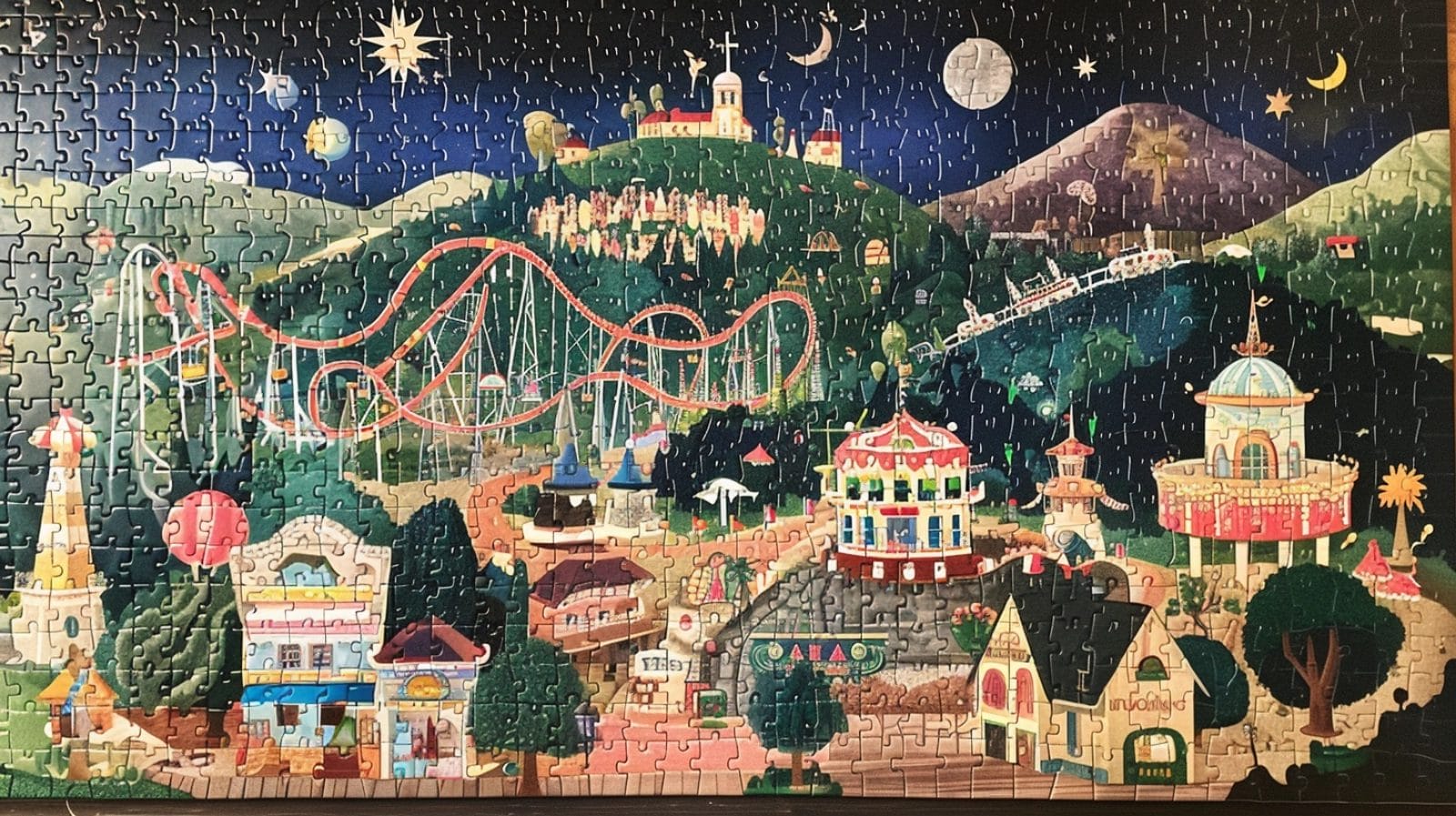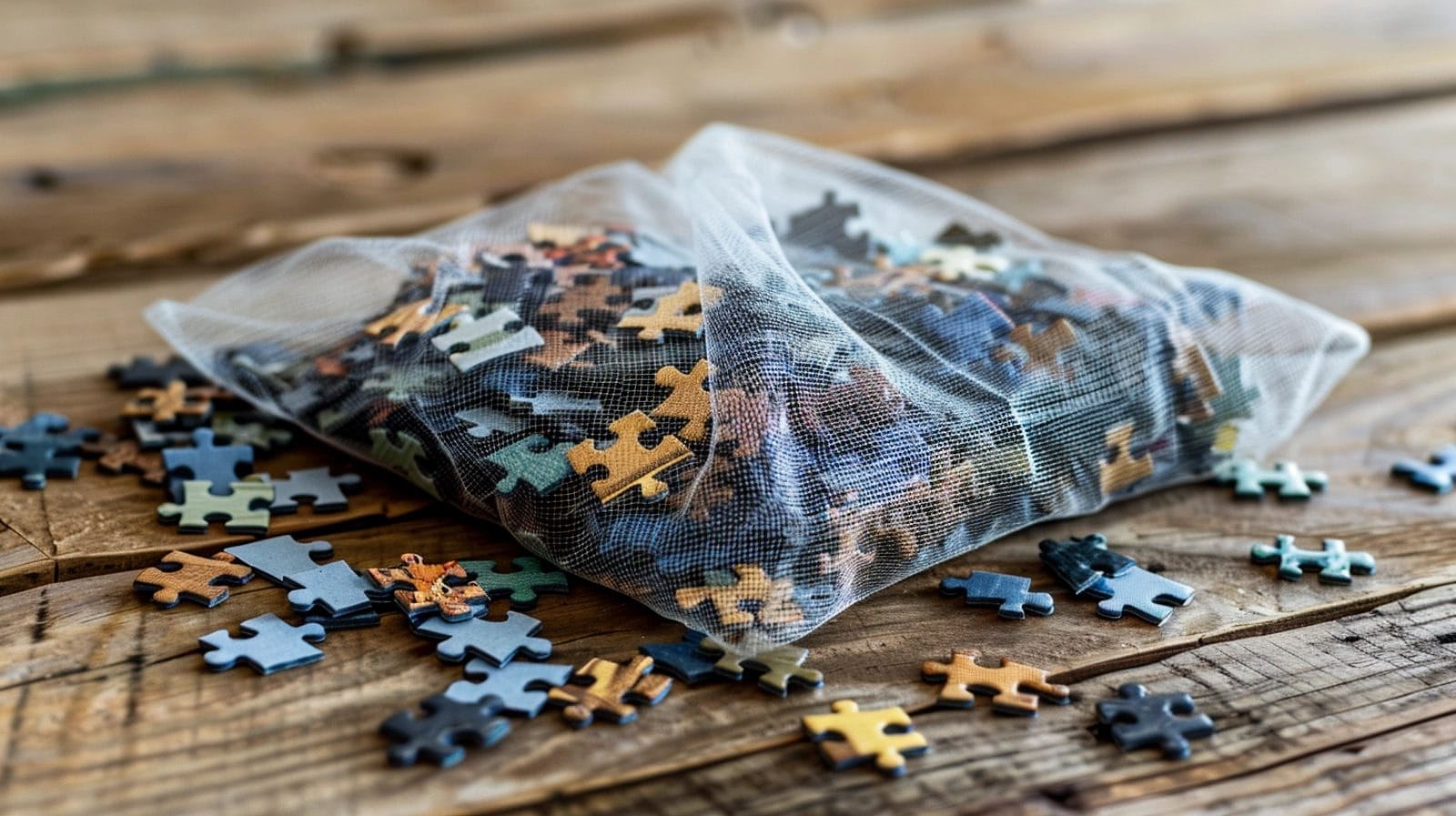
Are you a puzzle enthusiast looking to keep your collection organized? Storing puzzles can be a delightful challenge in itself. But with the proper techniques, you can transform your puzzle storage into a well-organized haven.
Are you ready to learn how to store puzzles? Let's explore innovative tips and creative solutions that will help you solve puzzles more effectively and with more excitement!
Key Takeaways
- Store completed puzzles in puzzle mats that can be rolled up. Or slide them into appropriately sized frames for permanent display.
- Use resealable plastic bags or sorting trays with lids to keep loose puzzle pieces organized.
- Keep puzzles in a cool, dry place away from direct sunlight to prevent warping and color fading.
- Count and clean all pieces before storage. Remove dust and debris to maintain puzzle quality.
- Organize puzzles in labeled storage bins or dedicated shelving systems. You can categorize them by theme or piece count.
How to Store Assembled Puzzles

Completing a puzzle is just the beginning; preserving it is the next challenge. Let's look at some storage options.
Puzzle Mats
Puzzle mats are excellent if you've completed a puzzle but aren't ready to break it apart. Unlike a rigid puzzle board, you can easily roll up puzzle mats with your finished work intact.
While they're not ideal for assembling puzzles due to stability issues, these puzzle savers offer a practical alternative to puzzle glue for temporary storage and transportation.
Puzzle Glue
To store an assembled puzzle with glue, place it on wax paper or a plastic sheet. Apply puzzle glue in the center and spread it evenly with a roller or brush, ensuring it fills the gaps between pieces.
Allow it to dry completely, forming a solid sheet. Once dry, you can frame the puzzle or store it flat to preserve your work.
Wire Racks
A wire rack storage system offers an ingenious way to preserve your assembled puzzles while maximizing vertical space. You can easily slide puzzles of various sizes, from 500 to 1,000 pieces, onto the racks.
This storage method securely holds your puzzle pieces. It prevents warping, allows quick access to your collection, and maintains each puzzle's integrity.
How to Store Puzzle Pieces Together

Before you start assembling your puzzle, it's helpful to know how to store the pieces properly.
Sorting Trays
Organizing puzzle pieces in sorting trays provides an efficient system. Sorting trays with lids allow you to stack and store puzzles in an organized way.
These solutions are helpful when working on complex puzzles or in limited space. Choose neutral-colored trays to maintain a tidy workspace while focusing on specific sections.
Plastic Storage Bags
Clear plastic storage bags help preserve puzzle pieces while maximizing storage space. Consider using sturdy Ziploc bags for visibility. But opt for rigid plastic pouches when stacking is needed.
To optimize your puzzle storage, cut out the box image and place it in front of the pouch. Arrange the pieces neatly behind it.
Mesh Bags
Mesh bags are ideal for organizing and displaying puzzle pieces. These transparent containers make it easy to store jigsaw puzzles while maintaining a clear view of your collection.
Mesh bags protect each puzzle piece from dust. You can stack them efficiently in drawers. Plus, they take up less space than traditional boxes. They're perfect for both completed and in-progress jigsaw puzzles.
Plastic Storage Bins
While mesh bags offer flexibility, plastic storage bins provide a more robust solution. When selecting a puzzle storage box, choose clear containers to spot your puzzles easily.
Stack storage boxes efficiently, and label each one with the puzzle's name and piece count. These puzzle storage options work best when you've sorted pieces by color or pattern.
Pencil Cases
Pencil cases offer a surprisingly versatile solution for storing puzzle pieces. They're handy for smaller puzzles or those you're working on in stages.
Using built-in compartments, this compact and organized storage method lets you sort pieces by color or shape.
Clear Envelope Folders
Clear envelope folders are an efficient storage solution. This is thanks to their transparency and durable construction.
Place them on a piece of cardboard or foam for extra stability. Then, stack them vertically to save space. You can keep the puzzle pieces separate and easily accessible.
How to Maintain Puzzle Condition for Storage
Ensuring proper puzzle care is key. Let's explore how to maintain them effectively for storage.
Environmental Considerations
Proper environmental conditions are vital to preserving puzzles. When deciding where to store your pieces, choose a cool, dry location away from direct sunlight.
It's the perfect time to store a puzzle when you've found a temperature-controlled space. Don't stack too many boxes, as excess weight can damage the ones below.
Regular Checks
Regular maintenance checks also help protect your puzzle collection. Inspect for loose pieces regularly and guarantee all pieces remain together.
Use a soft cloth to remove dust from the puzzle surface. Check for signs of warping or damage. Rotate the puzzle's orientation to prevent permanent indentation of the pieces.
Conclusion: How to Store Puzzles
Proper storage techniques will extend the lifespan of your puzzles and maintain their pristine condition. To do this, implement a systematic approach by cleaning, sorting, and cataloging each puzzle.
Don't forget to control environmental factors and handle pieces carefully. Your organized storage system will guarantee your collection remains intact for years to come.
FAQs
What's the Best Way to Store Puzzles?
Store your puzzles in transparent, rigid pouches with photos visible. For works-in-progress, use sorting trays, roll-up mats, and felt-backed boards. Secure completed puzzles with glue before framing them.
How to Store Puzzles When Finished?
Frame your completed puzzle, use puzzle preserver sheets, or apply puzzle conserver to keep it intact. For long-term storage, roll it up in a felt mat or secure it on a dedicated board.
How Do You Save a Puzzle After It's Done?
Apply the puzzle conserver, transfer it to a felt mat or cardboard base, and either frame it or roll it up. For long-term storage, you can use puzzle preserver sheets and store them flat.
How to Store a 1000 Piece Puzzle?
Place your 1000-piece puzzle in a stiff, transparent pouch with the box's image in front. Stack these pouches in bins or baskets, making sure they're flat to maintain their shape.